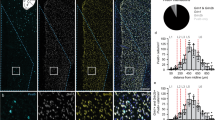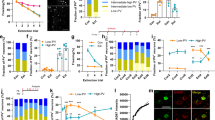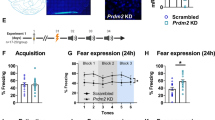Abstract
Prefrontal parvalbumin (PV) neurons play crucial roles in various distinct functions, while malfunction of PV-neurons also has critical contributions to various brain diseases, including both psychiatric and neurodegenerative disorders. However, whether the prefrontal cortex (PFC) PV-neurons participating in these functions and malfunctions are distinct subpopulations is not well understood. This question is important for a better understanding of both the basic properties/function of PV-neurons and inhibitory neurons in general, and for potential comorbid occurrence of dysfunctions in disease settings. Here, we analyzed dorsomedial prefrontal cortex (dmPFC) PV-neurons participating in working memory, modulation of conditioned fear memory, and anxiety, regarding their relative localization, electrophysiological properties, and synaptic inputs. In addition, by using activity-dependent tagging method, we examined whether manipulating the dmPFC PV-neurons participating in one function may affect another function as a way to test for potential functional interactions between them. We found that: (1) one single group of dmPFC PV-neurons participating in the two forms of modulation of conditioned fear memory, based on their high overlap in localization and mutual functional interactions with each other. (2) dmPFC PV-neurons participating in fear memory modulation and anxiety are two different subpopulations, with unique electrophysiological properties. (3) dmPFC PV-neurons participating in working memory and fear memory modulation are two different subpopulations, with different synaptic and neuronal properties. These findings provide important insights into the organization of PV-neurons in the PFC and highlight the distinct and non-interacting nature of different PV-subpopulations in the PFC functional diversity.
This is a preview of subscription content, access via your institution
Access options
Subscribe to this journal
Receive 13 print issues and online access
$259.00 per year
only $19.92 per issue
Buy this article
- Purchase on SpringerLink
- Instant access to full article PDF
Prices may be subject to local taxes which are calculated during checkout





Similar content being viewed by others
Data availability
The data supporting the findings of this study are available within the paper and its Supplementary Materials.
References
Chen Q, Deister CA, Gao X, Guo B, Lynn-Jones T, Chen N, et al. Dysfunction of cortical GABAergic neurons leads to sensory hyper-reactivity in a Shank3 mouse model of ASD. Nat Neurosci. 2020;23:520–32.
Lewis DA. Inhibitory neurons in human cortical circuits: substrate for cognitive dysfunction in schizophrenia. Curr Opin Neurobiol. 2014;26:22–6.
Nakazawa K, Zsiros V, Jiang Z, Nakao K, Kolata S, Zhang S, et al. GABAergic interneuron origin of schizophrenia pathophysiology. Neuropharmacology. 2012;62:1574–83.
Palop JJ, Mucke L. Network abnormalities and interneuron dysfunction in Alzheimer disease. Nat Rev Neurosci. 2016;17:777–92.
Hattori R, Kuchibhotla KV, Froemke RC, Komiyama T. Functions and dysfunctions of neocortical inhibitory neuron subtypes. Nat Neurosci. 2017;20:1199–208.
DeFelipe J. Neocortical neuronal diversity: chemical heterogeneity revealed by colocalization studies of classic neurotransmitters, neuropeptides, calcium-binding proteins, and cell surface molecules. Cereb Cortex. 1993;3:273–89.
Kawaguchi Y. Kubota Y. GABAergic cell subtypes and their synaptic connections in rat frontal cortex. Cereb Cortex. 1997;7:476–86.
Ferguson BR, Gao WJ. PV Interneurons: critical regulators of E/I balance for prefrontal cortex-dependent behavior and psychiatric disorders. Front Neural Circuits. 2018;12:37.
Ruden JB, Dugan LL, Konradi C. Parvalbumin interneuron vulnerability and brain disorders. Neuropsychopharmacology. 2021;46:279–87.
Selten M, van Bokhoven H, Nadif Kasri N. Inhibitory control of the excitatory/inhibitory balance in psychiatric disorders. F1000Res. 2018;7:23.
Page CE, Coutellier L. Prefrontal excitatory/inhibitory balance in stress and emotional disorders: evidence for over-inhibition. Neurosci Biobehav Rev. 2019;105:39–51.
Menon V, D’Esposito M. The role of PFC networks in cognitive control and executive function. Neuropsychopharmacology. 2022;47:90–103.
Friedman NP, Robbins TW. The role of prefrontal cortex in cognitive control and executive function. Neuropsychopharmacology. 2022;47:72–89.
Klune CB, Jin B, DeNardo LA. Linking mPFC circuit maturation to the developmental regulation of emotional memory and cognitive flexibility. Elife. 2021;10:e64567.
Rescorla RA. Conditioned inhibition of fear resulting from negative CS-US contingencies. J Comp Physiol Psychol. 1969;67:504–9.
Kim JJ, Jung MW. Neural circuits and mechanisms involved in Pavlovian fear conditioning: a critical review. Neurosci Biobehav Rev. 2006;30:188–202.
Curzon P, Rustay NR, Browman KE. Frontiers in Neuroscience Cued and Contextual Fear Conditioning for Rodents. In: Buccafusco JJ, editor Methods of Behavior Analysis in Neuroscience. Boca Raton (FL): CRC Press/Taylor & Francis. 2009.
Morrison FG, Ressler KJ. From the neurobiology of extinction to improved clinical treatments. Depress Anxiety. 2014;31:279–90.
Yan R, Wang T, Ma X, Zhang X, Zheng R, Zhou Q. Prefrontal inhibition drives formation and dynamic expression of probabilistic Pavlovian fear conditioning. Cell Rep. 2021;36:109503.
Courtin J, Chaudun F, Rozeske RR, Karalis N, Gonzalez-Campo C, Wurtz H, et al. Prefrontal parvalbumin interneurons shape neuronal activity to drive fear expression. Nature. 2014;505:92–6.
Wang T, Yan R, Zhang X, Wang Z, Duan H, Wang Z, et al. Paraventricular thalamus dynamically modulates aversive memory via tuning prefrontal inhibitory circuitry. J Neurosci. 2023;43:3630–46.
Wang Z, Wang Z, Zhou Q. Modulation of learning safety signals by acute stress: paraventricular thalamus and prefrontal inhibition. Neuropsychopharmacology. 2024;49:961–73.
Adhikari A, Topiwala MA, Gordon JA. Synchronized activity between the ventral hippocampus and the medial prefrontal cortex during anxiety. Neuron. 2010;65:257–69.
Padilla-Coreano N, Bolkan SS, Pierce GM, Blackman DR, Hardin WD, Garcia-Garcia AL, et al. Direct ventral hippocampal-prefrontal input is required for anxiety-related neural activity and behavior. Neuron. 2016;89:857–66.
Parfitt GM, Nguyen R, Bang JY, Aqrabawi AJ, Tran MM, Seo DK, et al. Bidirectional control of anxiety-related behaviors in mice: role of inputs arising from the ventral hippocampus to the lateral septum and medial prefrontal cortex. Neuropsychopharmacology. 2017;42:1715–28.
Shepard R, Coutellier L. Changes in the prefrontal glutamatergic and parvalbumin systems of mice exposed to unpredictable chronic stress. Mol Neurobiol. 2018;55:2591–602.
Page CE, Shepard R, Heslin K, Coutellier L. Prefrontal parvalbumin cells are sensitive to stress and mediate anxiety-related behaviors in female mice. Sci Rep. 2019;9:19772.
Yang SS, Mack NR, Shu Y, Gao WJ. Prefrontal GABAergic interneurons gate long-range afferents to regulate prefrontal cortex-associated complex behaviors. Front Neural Circuits. 2021;15:716408.
Arime Y, Saitoh Y, Ishikawa M, Kamiyoshihara C, Uchida Y, Fujii K, et al. Activation of prefrontal parvalbumin interneurons ameliorates working memory deficit even under clinically comparable antipsychotic treatment in a mouse model of schizophrenia. Neuropsychopharmacology. 2024;49:720–30.
Roux F, Wibral M, Mohr HM, Singer W, Uhlhaas PJ. Gamma-band activity in human prefrontal cortex codes for the number of relevant items maintained in working memory. J Neurosci. 2012;32:12411–20.
Murray AJ, Woloszynowska-Fraser MU, Ansel-Bollepalli L, Cole KL, Foggetti A, Crouch B, et al. Parvalbumin-positive interneurons of the prefrontal cortex support working memory and cognitive flexibility. Sci Rep. 2015;5:16778.
Buzsaki G, Wang XJ. Mechanisms of gamma oscillations. Annu Rev Neurosci. 2012;35:203–25.
Sohal VS, Zhang F, Yizhar O, Deisseroth K. Parvalbumin neurons and gamma rhythms enhance cortical circuit performance. Nature. 2009;459:698–702.
Yan R, Wang T, Zhou Q. Elevated dopamine signaling from ventral tegmental area to prefrontal cortical parvalbumin neurons drives conditioned inhibition. Proc Natl Acad Sci USA. 2019;116:13077–86.
Walf AA, Frye CA. The use of the elevated plus maze as an assay of anxiety-related behavior in rodents. Nat Protoc. 2007;2:322–8.
Seibenhener ML, Wooten MC. Use of the Open Field Maze to measure locomotor and anxiety-like behavior in mice. J Visual Exp. 2015;96:52434.
Deacon RM, Rawlins JN. T-maze alternation in the rodent. Nat Protoc. 2006;1:7–12.
Tonegawa S, Pignatelli M, Roy DS, Ryan TJ. Memory engram storage and retrieval. Curr Opin Neurobiol. 2015;35:101–9.
Wang W, Kim CK, Ting AY. Molecular tools for imaging and recording neuronal activity. Nat Chem Biol. 2019;15:101–10.
Kühn R, Torres RM. Cre/loxP recombination system and gene targeting. Methods Mol Biol. 2002;180:175–204.
Liu X, Ramirez S, Pang PT, Puryear CB, Govindarajan A, Deisseroth K, et al. Optogenetic stimulation of a hippocampal engram activates fear memory recall. Nature. 2012;484:381–5.
Goldberg EM, Clark BD, Zagha E, Nahmani M, Erisir A, Rudy B. K+ channels at the axon initial segment dampen near-threshold excitability of neocortical fast-spiking GABAergic interneurons. Neuron. 2008;58:387–400.
Bonetto G, Hivert B, Goutebroze L, Karagogeos D, Crepel V, Faivre-Sarrailh C. Selective axonal expression of the Kv1 channel complex in pre-myelinated GABAergic hippocampal neurons. Front Cell Neurosci. 2019;13:222.
Li KX, Lu YM, Xu ZH, Zhang J, Zhu JM, Zhang JM, et al. Neuregulin 1 regulates excitability of fast-spiking neurons through Kv1.1 and acts in epilepsy. Nat Neurosci. 2011;15:267–73.
Campanac E, Gasselin C, Baude A, Rama S, Ankri N, Debanne D. Enhanced intrinsic excitability in basket cells maintains excitatory-inhibitory balance in hippocampal circuits. Neuron. 2013;77:712–22.
Wang GH, Chuang AY, Lai YC, Chen HI, Hsueh SW, Yang YC. Pre-synaptic and post-synaptic A-type K(+) channels regulate glutamatergic transmission and switching of the network into epileptiform oscillations. Br J Pharm. 2022;179:3754–77.
Huang YC, Chen HC, Lin YT, Lin ST, Zheng Q, Abdelfattah AS, et al. Dynamic assemblies of parvalbumin interneurons in brain oscillations. Neuron. 2024;112:2600–13.e5.
Fukuda T, Kosaka T. Gap junctions linking the dendritic network of GABAergic interneurons in the hippocampus. J Neurosci. 2000;20:1519–28.
Fukuda T, Kosaka T. Ultrastructural study of gap junctions between dendrites of parvalbumin-containing GABAergic neurons in various neocortical areas of the adult rat. Neuroscience. 2003;120:5–20.
Canetta S, Bolkan S, Padilla-Coreano N, Song LJ, Sahn R, Harrison NL, et al. Maternal immune activation leads to selective functional deficits in offspring parvalbumin interneurons. Mol Psychiatry. 2016;21:956–68.
Shao F, Fang J, Qiu M, Wang S, Xi D, Shao X, et al. Electroacupuncture ameliorates chronic inflammatory pain-related anxiety by activating PV interneurons in the anterior cingulate cortex. Front Neurosci. 2021;15:691931.
Garcia-Junco-Clemente P, Tring E, Ringach DL, Trachtenberg JT. State-dependent subnetworks of parvalbumin-expressing interneurons in neocortex. Cell Rep. 2019;26:2282–88.e3.
Dembrow N, Johnston D. Subcircuit-specific neuromodulation in the prefrontal cortex. Front Neural Circ. 2014;8:54.
Musall S, Kaufman MT, Juavinett AL, Gluf S, Churchland AK. Single-trial neural dynamics are dominated by richly varied movements. Nat Neurosci. 2019;22:1677–86.
Woodward E, Rangel-Barajas C, Ringland A, Logrip ML, Coutellier L. Sex-specific timelines for adaptations of prefrontal parvalbumin neurons in response to stress and changes in anxiety- and depressive-like behaviors. ENeuro. 2023;10:ENRURO.0300-22.2023.
Stefanova N, Bozhilova-Pastirova A, Ovtscharoff WA. Sex differences of parvalbumin-immunoreactive neurons in the rat brain. Biomed Rev. 1997;7:91–96.
Ulrich M, Pollali E, Çalışkan G, Stork O, Albrecht A. Sex differences in anxiety and threat avoidance in GAD65 knock-out mice. Neurobiol Dis. 2023;183:106165.
Li K, Nakajima M, Ibañez-Tallon I, Heintz N. A cortical circuit for sexually dimorphic oxytocin-dependent anxiety behaviors. Cell. 2016;167:60–72.e11.
Lopez-Larson MP, Anderson JS, Ferguson MA, Yurgelun-Todd D. Local brain connectivity and associations with gender and age. Dev Cognit Neurosci. 2011;1:187–97.
Crandall SR, Patrick SL, Cruikshank SJ, Connors BW. Infrabarrels are layer 6 circuit modules in the barrel cortex that link long-range inputs and outputs. Cell Rep. 2017;21:3065–78.
Zhang ZW, Deschenes M. Intracortical axonal projections of lamina VI cells of the primary somatosensory cortex in the rat: a single-cell labeling study. J Neurosci. 1997;17:6365–79.
Kepecs A, Fishell G. Interneuron cell types are fit to function. Nature. 2014;505:318–26.
Kvitsiani D, Ranade S, Hangya B, Taniguchi H, Huang JZ, Kepecs A. Distinct behavioural and network correlates of two interneuron types in prefrontal cortex. Nature. 2013;498:363–6.
Pinto L, Dan Y. Cell-type-specific activity in prefrontal cortex during goal-directed behavior. Neuron. 2015;87:437–50.
Tovote P, Fadok JP, Luthi A. Neuronal circuits for fear and anxiety. Nat Rev Neurosci. 2015;16:317–31.
Funding
This work is supported by grant from Shenzhen-Hong Kong Institute of Brain Science-Shenzhen Fundamental Research Institutions (2024SHIBS0004), National Natural Science Foundation of China (82204356), Shenzhen Government Basic Research Grant (JCYJ20220530160001002) and Shenzhen Children’s Hospital Fund (ynkt2021-zz24).
Author information
Authors and Affiliations
Contributions
Conceptualization: QZ, YH, JZ and XZ. Methodology: QZ, YH, JZ and XZ. Experiment and data analysis: YH, XZ, THF, TW, JZ and QZ. Writing: QZ, YH, YZ and XZ. Review and editing: QZ, YH, YZ and THF. Funding acquisition: QZ, JZ and YZ. Project administration: QZ. Supervision, QZ.
Corresponding author
Ethics declarations
Competing interest
The authors declare no competing interests.
Additional information
Publisher’s note Springer Nature remains neutral with regard to jurisdictional claims in published maps and institutional affiliations.
Supplementary information
Rights and permissions
Springer Nature or its licensor (e.g. a society or other partner) holds exclusive rights to this article under a publishing agreement with the author(s) or other rightsholder(s); author self-archiving of the accepted manuscript version of this article is solely governed by the terms of such publishing agreement and applicable law.
About this article
Cite this article
Hu, Y., Zhang, X., Fong, T.H. et al. Distinct subpopulations of parvalbumin neurons participating in divergent prefrontal functions. Neuropsychopharmacol. 50, 1502–1514 (2025). https://doi.org/10.1038/s41386-025-02159-3
Received:
Revised:
Accepted:
Published:
Issue date:
DOI: https://doi.org/10.1038/s41386-025-02159-3
This article is cited by
-
Prefrontal contribution to passive coping behaviour in chronic stress and treatment by fast-acting antidepressant
Neuropsychopharmacology (2025)



